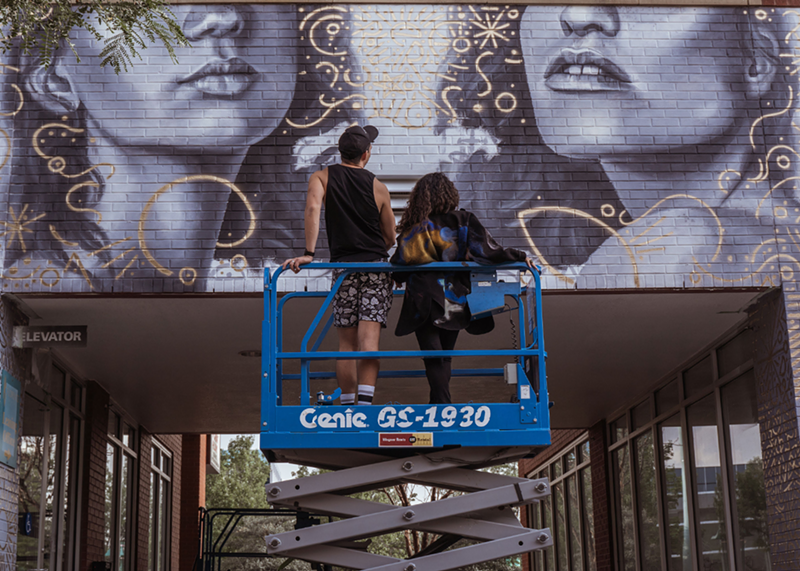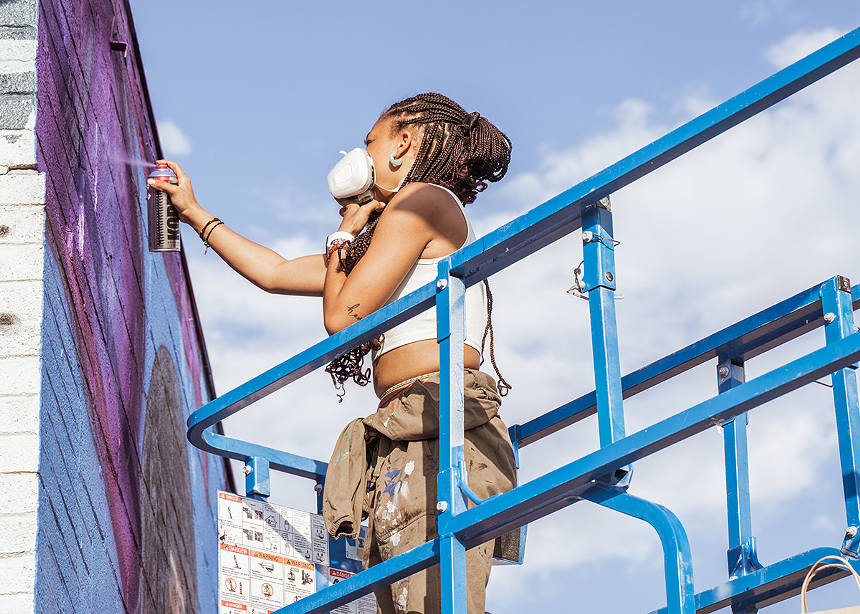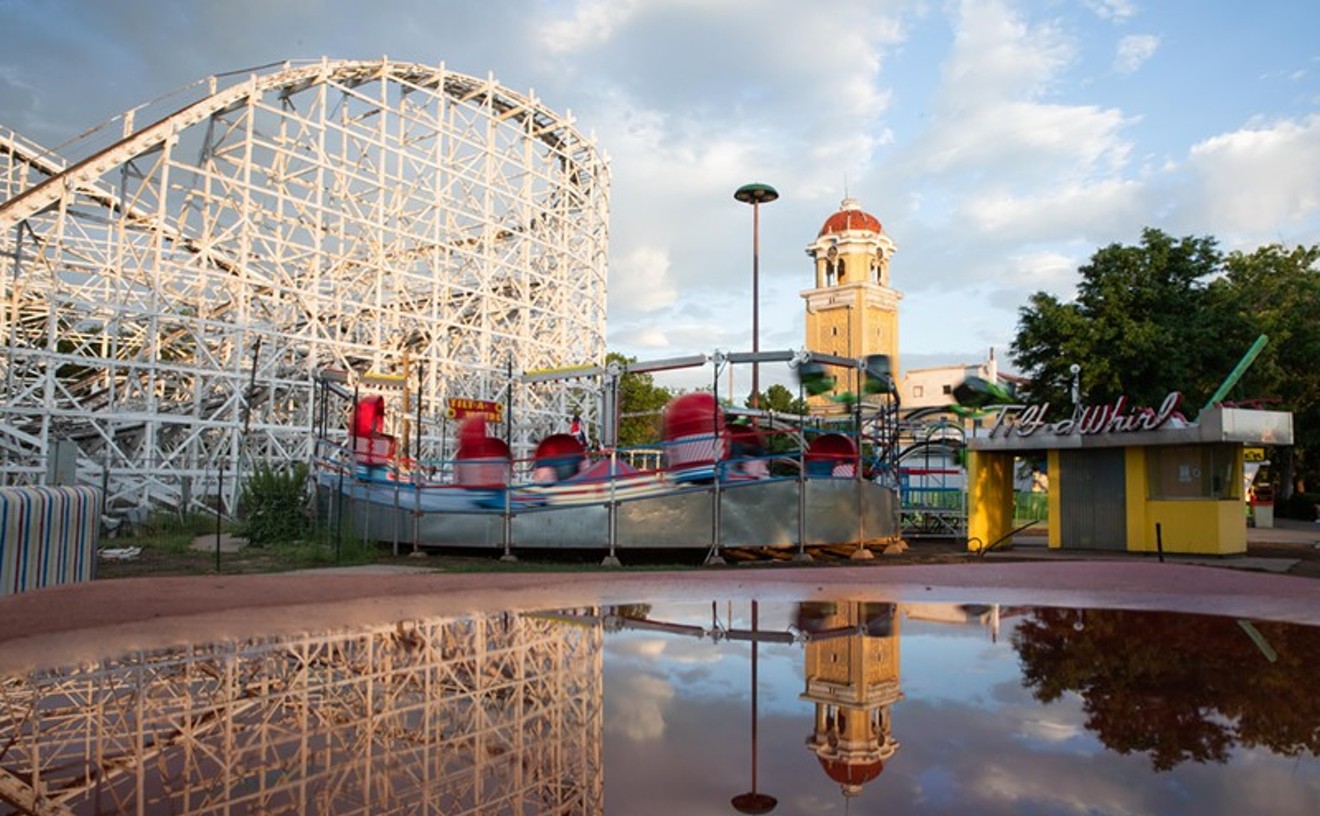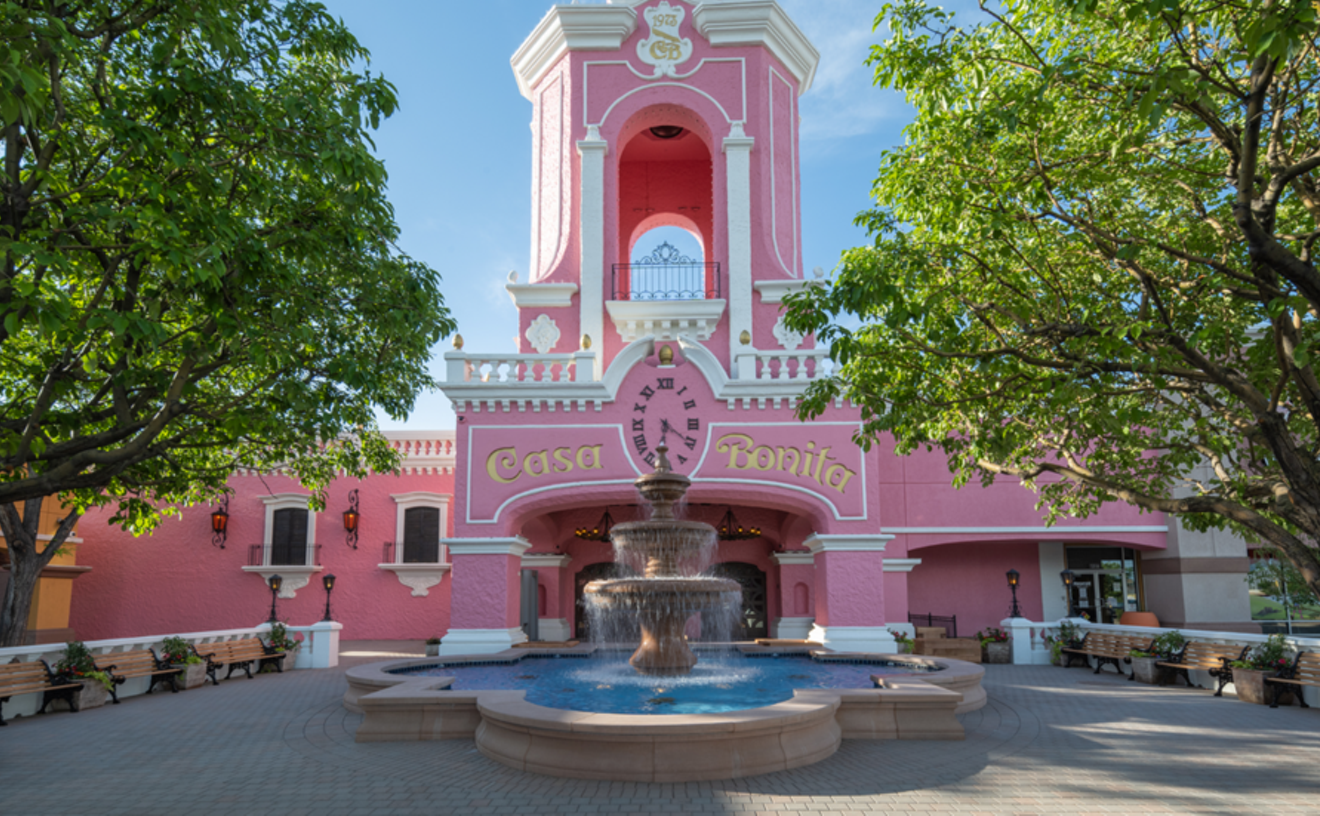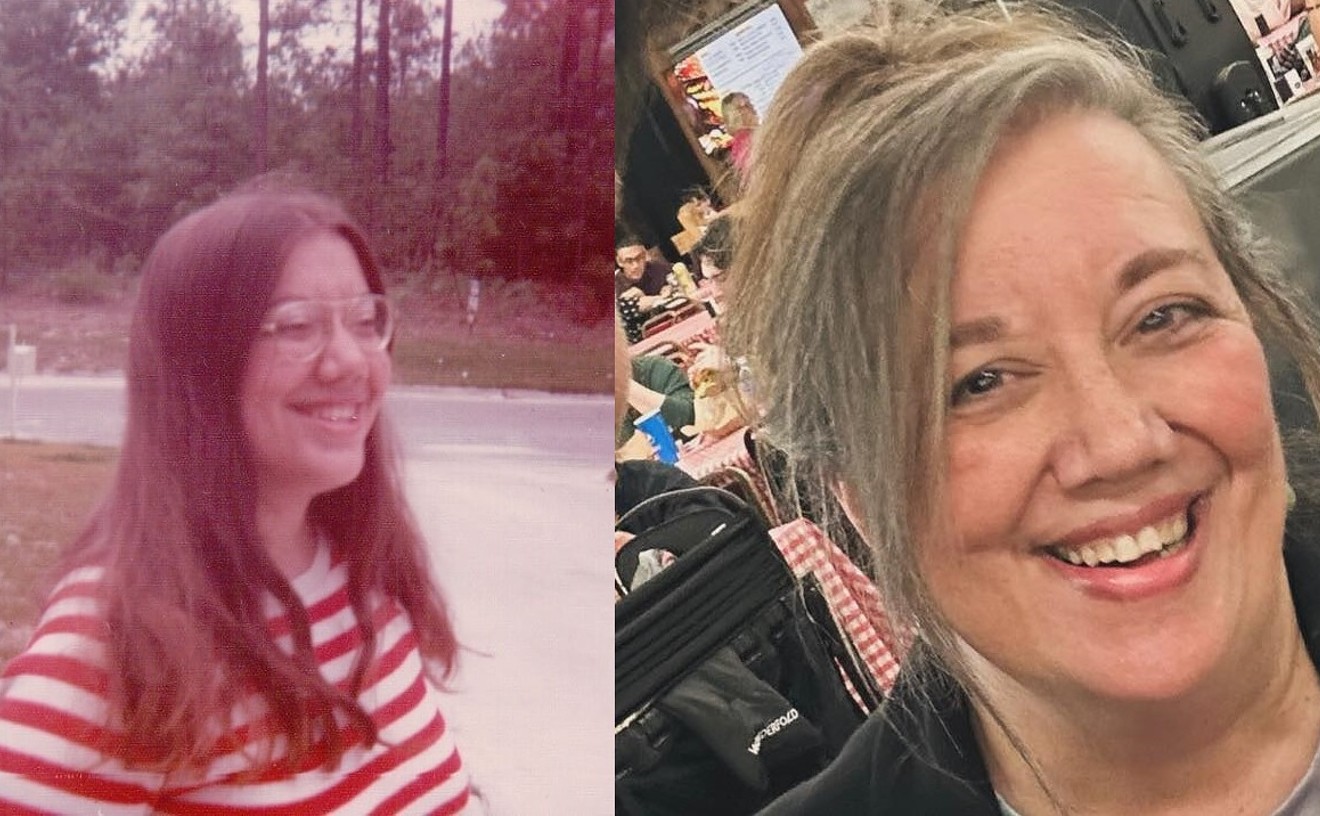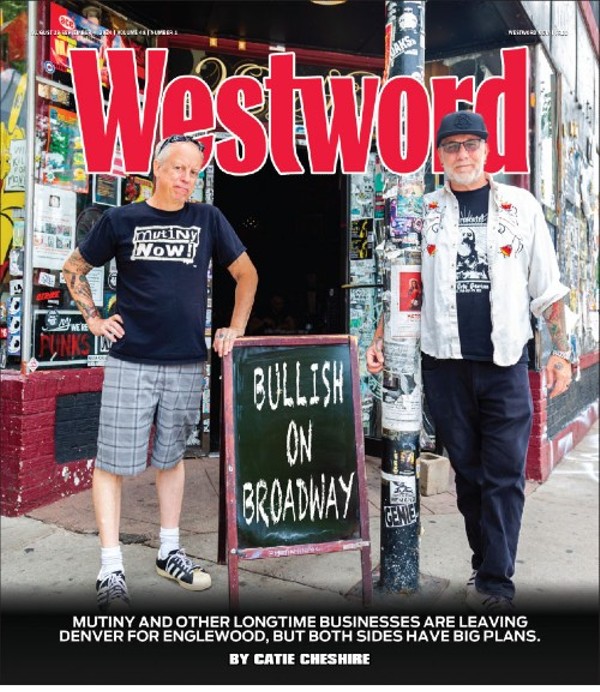It's a blazing August afternoon, and Aaron Vega is taking us on a tour of the bustling Aurora Cultural Arts District, which stretches along several busy blocks of East Colfax Avenue. We never make it more than a couple feet before he has a tantalizing new eatery or eye-catching mural to point out.
"There is a larger story to tell about East Colfax, and I think we often get pigeonholed into one," says the producer and curator as we stroll. "The second you spend more than five minutes in this area, you realize it is a vibrant community. There's all the pieces and parts you want for healthy society. The question is: Can we bring them together, support the good and try to make things better for everybody?"
For four years, Vega has been hard at work putting those pieces together as executive producer of the Colfax Canvas Mural Festival and block party, an event he founded with partners Kristin Sutter and Ryan Foo. An Auroran himself, his fest is responsible for the art that has abundantly blossomed throughout the neighborhood. Because of Colfax Canvas, there are now dozens of murals there, splashed across businesses, peeking out over rooftops and filling alleys with color. After Labor Day weekend, the painting period for the festival's fifth installment will begin, adding five new pieces to that count. A neighborhood block party with musicians, DJs, food and vendors at Fletcher Plaza will celebrate their completion from noon to 5 p.m. on Saturday, September 14.
Drawn from more than 130 applications, this year's artist teams include ILL.DES, Anna Charney and A.L. Grime (Mango House, 10180 East Colfax); George F. Baker III, Isaac Lucero and Sofi Rami (Scorpion Tax, 1408 Del Mar Parkway); Danielle SeeWalker and Cante Eagle Horse (DIA Market, 1408 Del Mar Parkway); and BiRD and Dreamscape (Vintage Theatre, 1468 Dayton).
A last-minute pop-up mural addition at Second Dawn Brewing Co. (2302 Dayton Street) will be painted by Skela as part of a partnership with the brewery to offer shuttle service on September 14 between the Fletcher Plaza block party and Stanley Marketplace. As in previous years, these artists represent the best mix of up-and-coming and veteran muralists in the metro area, with styles ranging from realistic to fantastic to cartoonish and everything in between. Walking tours during the block party and virtual tours provide a guide to the growing open-air gallery; as you explore the area, you can use each mural's pasted QR code for navigation.
Arranging its artists in teams sets Colfax Canvas a bit apart from other events of its kind, which tend to have a bill with headliners, à la music festivals. "Some artists, they're lone wolves, they want to work alone," notes Vega. "Totally respect it — that's just not our vibe."
Making Colfax Canvas entirely collaborative was one of several key changes implemented after its 2020 debut; the most notable other tweak was establishing a neighborhood Diversity, Equity, Inclusion and Accessibility committee for the selection process. In year one, Vega and his team partnered with popular local muralist Chad Bolsinger to source artists.
"He did an amazing job," recalls Vega, "but Kristin and Ryan and I sort of took a step back after it was done, and we went, 'I know this is how it's being done, where headliners get this much money and other people are painting for free. Like, I understand it intellectually, but it doesn't feel like it represents this neighborhood. It doesn't feel like it's a good model for this.'"
The city of Aurora, like the mural festival's artist lineup, is distinctly diverse. It has a larger percentage of Latino citizens than Denver, and the city is home to a sizable refugee population, with large communities of Ethiopian, Eritrean and Nepalese descent, among others, settling there in the last decade. Area foodies have become highly attuned to its jaw-dropping variety of eateries, both in the Arts District and in growing Korea Town to the south. After the first year of Colfax Canvas, when Vega realized that they were on to something, building out the DEIA component seemed a no-brainer.
"You can't really talk about art in this neighborhood unless you're talking about: Where do you come from? Who do you represent? Who do you feel like you speak for?" he says. "And those questions have been really exciting, because it means that the kind of artists we're bringing into the festival now is much more representative [of the city]."
A case in point is the return this year of one of the most notable Colfax Canvas alums: Lakota multi-disciplinary artist, muralist and activist Danielle SeeWalker. A citizen of the Standing Rock Sioux Tribe in South Dakota, SeeWalker brings a healthy dose of perspective and style from her heritage alongside her interest in mixed-media experimentation. Her work can already be found all over the Front Range, from Empower Field to CU Boulder, the Denver Indian Center, North High School and various neighborhood spots around town.
This will be her second appearance at the festival after taking part in a collaborative mural with Amanda Vela-Charbonneau, Cal Duran and Patrick Maxcy in 2021; she's also an organizer for Babe Walls, Denver's female, non-binary mural festival. That's where she met her painting partner for 2024, Cante Eagle Horse. This year, SeeWalker wanted to try something different from her typical use of strong colors, so they will be creating a grayscale mural with magpies and floral designs, which are significant in Lakota storytelling and visual aesthetics.
"My mural work is a lot different from my studio and fine-art practice," SeeWalker says. "I like to do a lot of bold, sort of flat, 2-D, graphic-type murals, very colorful. It is kind of inspired by something called ledger art, which is a Plains Indian style of artwork that is tied back to my ancestors. Before we had a written language, we documented everything by drawing."
Usually created on animal hide, ledger art was primarily practiced by a tribal member known as a "winter count keeper," who documented important happenings in the community through drawing. After the Lakota were forced onto reservations and forcibly removed from their hunting-based lifestyle, hide canvas was replaced by ledger paper, which began to be used for the same purpose. Today's Native artists often seek out these historical documents as an influence for their own modern practice.
"I do it in a mural form," SeeWalker says, "so my style lacks a lot of detail, but it's very bold, vibrant and graphic." The artist often uses this ancient format to represent Native people as they are today, sometimes with a mix of traditional and modern styles. "It's to really draw this concept of we still are here, but we keep our culture intact while also living in a contemporary society."
Navigating that duality can be tricky. In the case of Colfax Canvas, SeeWalker was concerned about aligning with the City of Aurora, which rejected a land acknowledgement proposal in 2022; the proposal was dismissed during a heated city council session in which conservative members claimed Aurora was "God's country." Land acknowledgements are formal verbal statements that recognize the historical facts regarding European settlers wresting land from the Indigenous, often violently. SeeWalker's mural was originally going to be funded by the city, but in light of its stance, she requested to be supported by a different entity. The artist, who has also served on the Denver American Indian Commission since 2019, says that the acknowledgement brouhaha raises significant issues.
"It's really exciting to create another [mural] and have that representation of Native, Indigenous art in Aurora," she says, "[but] they should be creating opportunities for Native people. ... I'm trying to get a meeting with city council to discuss their issues with [acknowledgment]. I'm taking up space as an artist in the city of Aurora, and I'm really happy about that, but there's still a lot of work to be done when it comes to recognizing diversity in that town."
To be sure, the joyful, diverse mural festival contrasts with other Aurora headlines, such as the revolving door of police chiefs running a department internationally reviled for its role in the 2019 death of Elijah McClain. Vega is the first to admit that the city is a large, complex place with many stakeholders, and is quick to defend the work of city government officials trying to push things forward.
"Aurora is massive," he says. "I don't think people realize how much square footage Aurora covers, the diversity of Aurora. ... It's a fascinating place with a lot of dynamics. So there's a lot of push and pull, and our political climate right now is what it is, and so I think there's a lot of folks that are working really hard to make sure that people are seen and heard."
For Vega, the goal is to bring joy through art for regular people going about their lives on East Colfax. He relates a story of a young girl with her mother noticing the Spanish text incorporated into a Charlo mural (in this case, the native language of both artist and spectator). "She couldn't have been more than six years old, and her eyes just lit up, because she could read, in her own language, something that was going into a beautiful piece of art that was outside of her doorstep," he says.
In that moment, it became clear to him how important it was for the people of Aurora to beautify their city. "It's been fun to watch the neighborhood and the businesses embrace it. The residents embraced it from day one," he attests. These days, small-business owners hunt him down, clamoring for a mural, and when he cold-calls them to gauge interest, all he has to do to prove his credentials is step outside and point.
Vega says the art proves to all visitors that "people do care."
"We live here. We love this place. We don't want to see it turn into a giant multi-million condo unit and strip malls. We want to keep its character," he concludes. "If we can keep some of the flavor, if we can help represent the community through the artists and the art, then we're doing our job."
Colfax Canvas Mural Festival, noon to 5 p.m. Saturday, September 14, Fletcher Plaza, 9800 East Colfax Avenue, Aurora.

Audio By Carbonatix
[
{
"name": "Air - MediumRectangle - Inline Content - Mobile Display Size",
"component": "12017618",
"insertPoint": "2",
"requiredCountToDisplay": "2",
"watchElement": ".fdn-content-body",
"astAdList": [
{
"adType": "rectangle",
"displayTargets": "mobile"
}
]
},{
"name": "Editor Picks",
"component": "17242653",
"insertPoint": "4",
"requiredCountToDisplay": "1",
"watchElement": ".fdn-content-body",
"astAdList": [
{
"adType": "rectangle",
"displayTargets": "desktop|tablet"
},{
"adType": "rectangle",
"displayTargets": "desktop|tablet|mobile"
}
]
},{
"name": "Inline Links",
"component": "18838239",
"insertPoint": "8th",
"startingPoint": 8,
"requiredCountToDisplay": "7",
"maxInsertions": 25
},{
"name": "Air - MediumRectangle - Combo - Inline Content",
"component": "17261320",
"insertPoint": "8th",
"startingPoint": 8,
"requiredCountToDisplay": "7",
"maxInsertions": 25,
"watchElement": ".fdn-content-body",
"astAdList": [
{
"adType": "rectangle",
"displayTargets": "desktop|tablet"
},{
"adType": "rectangle",
"displayTargets": "desktop|tablet|mobile"
}
]
},{
"name": "Inline Links",
"component": "18838239",
"insertPoint": "8th",
"startingPoint": 12,
"requiredCountToDisplay": "11",
"maxInsertions": 25
},{
"name": "Air - Leaderboard Tower - Combo - Inline Content",
"component": "17261321",
"insertPoint": "8th",
"startingPoint": 12,
"requiredCountToDisplay": "11",
"maxInsertions": 25,
"watchElement": ".fdn-content-body",
"astAdList": [
{
"adType": "leaderboardInlineContent",
"displayTargets": "desktop|tablet"
},{
"adType": "tower",
"displayTargets": "mobile"
}
]
}
]

